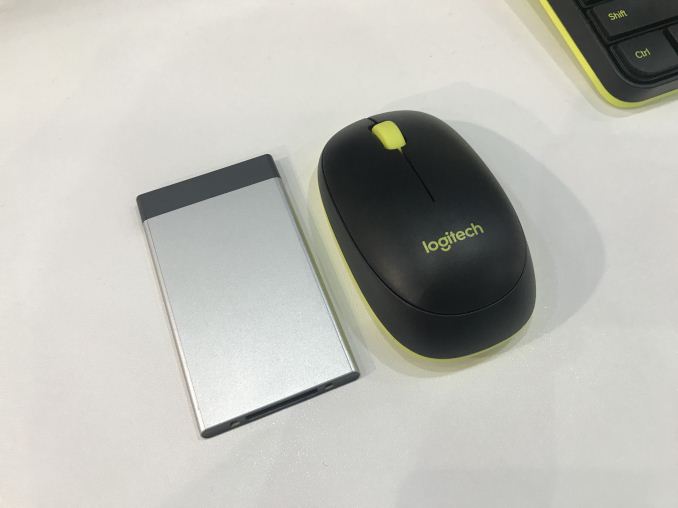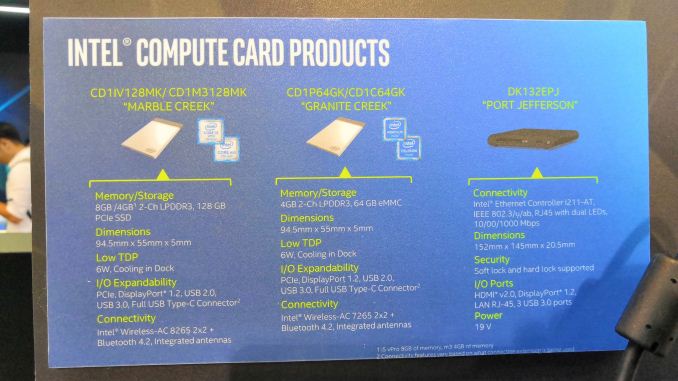ECS with Intel Compute Card: What Happened to Intel’s Compute Card?
by Ian Cutress on June 19, 2018 2:00 PM EST- Posted in
- Systems
- Intel
- Trade Shows
- Core M
- Compute Card
- Computex 2018

One of the more interesting and innovative platforms that Intel has introduced over the past few years was the Compute Card: a small credit-card like platform that contained a CPU, some memory, some storage, and a connector such that the card could be placed into all manner of docks and displays for a universal homogenous experience. The Compute Card arrived with much fanfare, but since then I have not heard much about it, let alone see one in real life. That changed with a visit to ECS at Computex.
ECS is one of Intel’s biggest engineering and manufacturing partners, taking on a lot of the Intel branded product contracts, such as the NUC. On display at their booth was the Intel Compute Card platform in two variants: first, a dock embedded in a touch screen display, and second as a dock that could be connected to a display. It’s that second one that interested me most.
Because the Compute Card is small, and super thin (it’s difficult to get over just how thin it is), the idea that you can take almost a full x86 computer with you to different points is pretty crazy. This is the point where someone mentions a smartphone, which I concede, but the Compute Card is so much smaller. The base design has either a Core-Y series processor or an Atom processor inside, and the dock provides the additional cooling and extension to things like networking, display, and USB. It’s like putting a credit card in a DVD drive hooked up to a monitor.
The one thing about when the Compute Card was launched that didn’t click immediately was the thermals. The docks in this case have to assist with the cooling – the thin metal chassis of the compute card is not enough, especially when the CPU can draw up to 6W. As a result, when a user needs to remove the Compute Card, they have to wait until the temperature decreases to something human friendly. Both myself and Anton commented that after ejecting the Compute Card, the temperature of the unit was quite toasty.
The dock ECS had on display was the DK132EPJ, or what Intel calls the ‘Port Jefferson’ platform. My ECS contact said, when I wanted to have a look at the Compute Card devices, ‘why do you want to look at something so old?’. The question itself kind of shows the two points about where the Compute Card stands today: not only have I not seen it up until now, it also has not been updated to the latest designs. It would seem that the power it provides is already sufficient for the markets its wants, or future products might be too power hungry for it.
Is the Compute Card a success? I don’t really know. If it’s taken me this long to even see one in person, then it’s either a ‘no’, or I’m just not following that market often enough. If one thing is for sure, there haven’t been any updates from Intel, which is a shame.
Edit: Imagine a cluster of these things: a dock that supports a hundred of them.
| Want to keep up to date with all of our Computex 2018 Coverage? | ||||||
 Laptops |
 Hardware |
 Chips |
||||
| Follow AnandTech's breaking news here! | ||||||















26 Comments
View All Comments
Amandtec - Tuesday, June 19, 2018 - link
The same thing can kind of be achieved with virtual desktop. All I imagine is asking a client if I can plug by card into one of their computers and watching in horror as all hell breaks lose because their IT guy thinks I am trying to hack them or something. Impressive engineering but it has no good use case in business or personal use scenarios.jtd871 - Tuesday, June 19, 2018 - link
Move over ECS: let AsRock have a go at this form factor. Seriously, it wouldn't be too difficult to put the base card in a textured machined or extruded aluminum shell with more heat dissipation potential. It should also be possible to update the guts to a more modern and lower-power SOC to help with thermals. Unfortunately, Ian, it's a niche and proprietary product: https://www.anandtech.com/show/11019/intel-compute...Ket_MANIAC - Tuesday, June 19, 2018 - link
Zotac showed it off at Computex this year. Seriously AnandTech, you are falling behind. Look for the Zotac P series.jordanclock - Tuesday, June 19, 2018 - link
The P series isn't quite the same. That is a complete package, including I/O. The compute card has no I/O, except to interface with some kind of enclosure to provide user interactivity.Ket_MANIAC - Wednesday, June 20, 2018 - link
So how is it innovative and functional when other companies have better working actual products of your "still to be released concepts"? IMO another handicapped Intel brand.FanlessTech - Tuesday, June 19, 2018 - link
It's a really cool idea but Intel's Compute Stick previously bombed for a reason. Pocketable PCs are a gimmick.Sure the Compute Card is different (and actually smarter) but it's also so more complex to use and deploy. And poor thermals again?
The Core-Y is an absolute MARVEL at 5W TDP. It could power amazing (and actually usable without docks and dongles) NUC-sized fanless PCs if it wasn't so expensive.
Araemo - Tuesday, June 19, 2018 - link
My first reaction: Huh, that'd be kinda neat.My second reaction: all my use cases are stupid.
"I could use that to have a secure PC I log into my bank from wherever I go", but really: I could never trust the dock to not have a keylogger built in. Or a display image capture device.
It'd be a lot like using a kiosk PC somewhere to do something secure, but with all of the avenues for exploit hidden in the hardware, nothing software-detectable. Sure, it removes one layer of possible exploits (software-based), but you could never actually trust these to be secure. If you just want your gaming pc on a card.. cool.... except the form factor prevents it from having any high power cpu/gpu.
jordanclock - Tuesday, June 19, 2018 - link
I think there is something to be said for business uses. Moving this between a corporate and home dock could allow for safe transportation of all data, even your OS, in something smaller than a laptop. I could personally use something like this because I do almost all my work at the office but occasionally work from home. My laptop is almost always at the office.Spunjji - Wednesday, June 20, 2018 - link
I can't see many situations in which this would make more sense than a laptop, though. At least there you can work wherever you can set the thing down. This limits you to whichever locations already have a dock set up. In the meantime all that extra kit (monitor, keyboard, mouse) is completely useless until the card is docked. If you wanted to dual-use it with an actual home PC then you'd need to splurge on a KVM, too.dullard - Tuesday, June 19, 2018 - link
I think you are looking at it backwards. I agree that the use cases for a home user usually fall apart. But think about it from a business standpoint. Instead of expensive serving/upgrading kiosks for a new purpose, just pull out a card, slip in the new card and you have a whole new product. I don't think these will take off if they are user accessible. But, if they are technician accessible, then I see many use cases.Here is another company using them: https://www.dtx.com/files/documents/product-data/C...